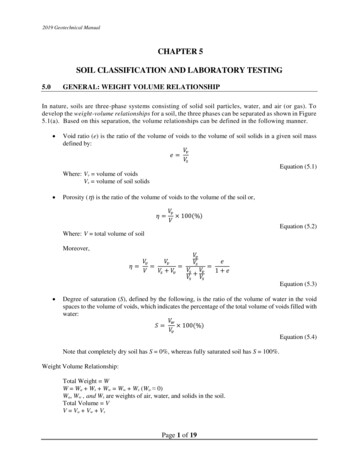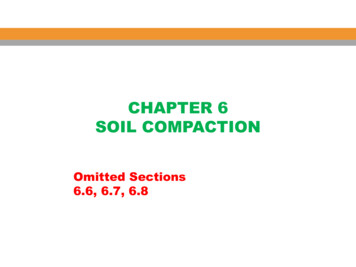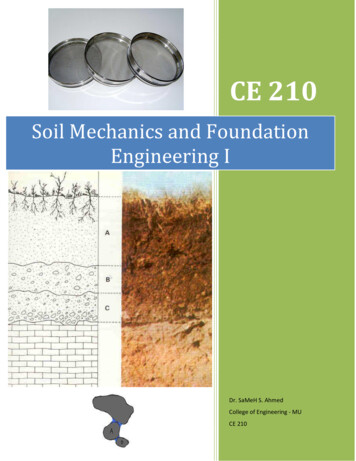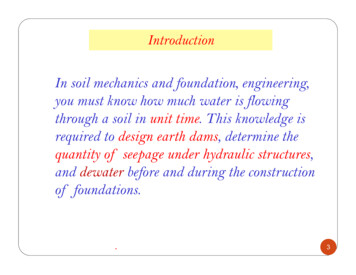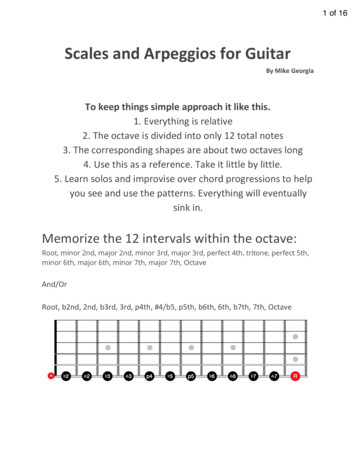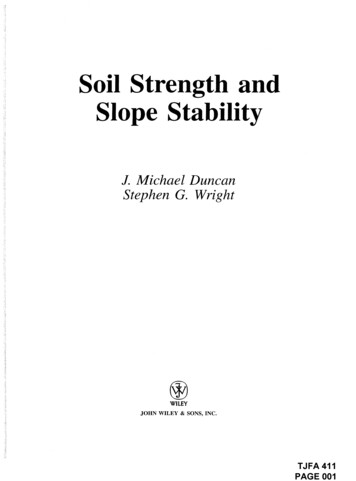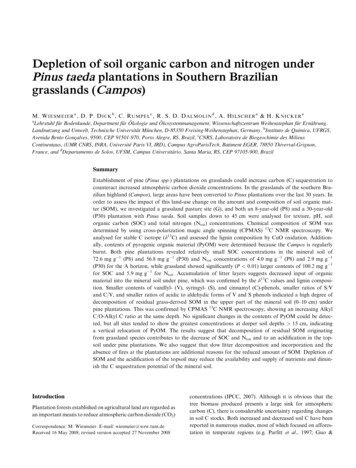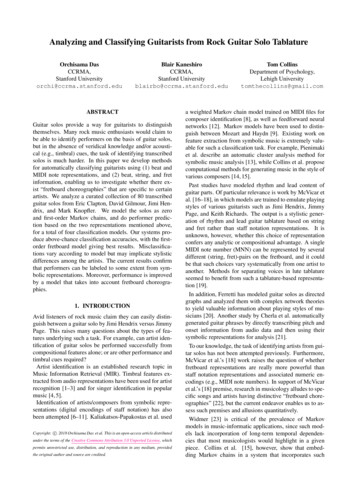
Transcription
Chapter 44 .1Soil and Rock Classification and LoggingOverviewThe detailed description and classification of soil and rock are an essential part of thegeologic interpretation process and the geotechnical information developed to supportdesign and construction. The description and classification of soil and rock includesconsideration of the physical characteristics and engineering properties of the material.The soil and rock descriptions that are contained on the field logs should be based onfactual information. Interpretive information should not be included on the field logs,but provided elsewhere, such as in the text of geological, and geotechnical reports.This chapter provides standards for describing and logging soil and rock.The Unified Soil Classification System, as outlined in ASTM 2488 – “StandardPractices for Description of Soils (Visual – Manual Procedure)”, provides aconventional system for classifying soils. However, it alone does not provide adequatedescriptive terminology and criteria for identifying soils for engineering purposes.Therefore, the ASTM Standard has been modified to account for these additionaldescriptive terms and criteria. It is not intended to replace the standard but to improveupon it, and make it better understood.There are numerous rock classification systems, but none of these is universally used.This chapter provides a composite of those classification systems that incorporates thesignificant descriptive terminology relevant to geotechnical design and construction.An important facet of soil and rock classification is the determination of whatconstitutes “rock”, as opposed to extremely weathered, partially cemented, or alteredmaterial that approaches soil in its character and engineering characteristics. Extremelysoft or decomposed rock that is friable (easily crumbled), and can be reduced to gravelsize or smaller by normal hand pressure, should be classified as a soil.4.2Soil ClassificationSoil classification, for engineering purposes, is based on the distribution and behaviorof the fine-grained and coarse-grained soil constituents. Soil descriptions that arecontained on the field exploration logs are based on modified procedures as outlinedin ASTM 2488. The visual - manual procedure provided in this standard utilizesvisual observation and simple field index tests to identify the characteristics of the soilconstituents. Definitions for the various soil constituents can be found in Table 4-1.In addition, soil properties that address angularity, consistency/relative density, color,moisture, structure, etc. have been defined.Soils are divided into four broad categories. These soil categories are coarse-grainedsoils, fine-grained inorganic soils, organic soils, and peat. The first step in identifyingsoil is to make a determination regarding which of the four broad categories the soilbelongs. The definitions for these broad categories are as follows: Coarse Grained Soils: Soils that contain 50 % or less of soil particles passing a0.0030 in. (0.075 mm) opening.WSDOT Geotechnical Design ManualOctober 2013M 46-03.08Page 4-1
Soil and Rock Classification and LoggingChapter 4 Fine Grained Inorganic Soils: Soils that contain more than 50 % of soil particlespassing a 0.0030 in. (0.075 mm) opening. Fine Grained Organic Soils: Soils that contain enough organic particles to influencethe soil properties. Peat: Soils that are composed primarily of vegetative tissue in various stagesof decomposition that has a fibrous to amorphous texture, usually dark brownto black, and an organic odor are designated as a highly organic soil called peat.Once a soil has been identified as a peat (group symbol PT), the soil should notbe subjected to any further identification les of rock that will not pass through a 12 in. opening.CobbleParticles of rock that will pass through a 12 in. opening, but will not passthrough a 3 in. opening.GravelParticles of rock that will pass through a 3 in. opening, but will not pass a0.19 in. (4.75 mm) opening.SandParticles of rock that will pass through a 0.19 in. (4.75 mm) opening, butwill not pass a 0.003 in. (0.075 mm) opening.SiltSoil that will pass through a 0.003 in. (0.075 mm) opening that is nonplastic or very slightly plastic and exhibits little or no strength whenair-dried.ClaySoil that will pass through a 0.003 in. (0.075 mm) opening that can bemade to exhibit plasticity (putty-like properties) within a range of watercontents, and exhibits considerable strength when air-dried.Organic SoilPeatSoil that contains enough organic particles to influence the soilproperties.Soil that is composed primarily of vegetable tissue in various stages ofdecomposition usually with an organic odor, a dark brown to black color,a spongy consistency, and a texture ranging from fibrous to amorphous.Soil Constituent DefinitionTable 4-14.2.1Coarse Grained SoilsCoarse grained soils are classified as either a gravel or a sand, depending on whetheror not the percentage of the coarse grains are larger or smaller than a 0.19 in. (4.75mm) opening. A soil is defined as a gravel when the estimated percentage of the gravelsize particles is greater than the sand size particles. A soil is defined as a sand when theestimated percentage of the sand size particles are greater than the gravel size particles.If the soil is classified as a gravel, it is then identified as either clean or dirty. Dirtymeans that the gravel contains an appreciable (greater than 10 %) amount of materialthat passes a 0.003 in. (0.075 mm) opening (fines), and clean means that the gravelis essentially free of fines (less than 10 %). The use of the terms clean and dirty arefor distinction purposes only and should not be utilized in the description containedon the field log.Page 4-2WSDOT Geotechnical Design Manual M 46-03.08October 2013
Chapter 4Soil and Rock Classification and LoggingIf the gravel is clean then gradation criteria apply, and the gravel is classified as eitherwell graded (GW) or poorly graded (GP). Well graded is defined as a soil that has awide range of particle sizes and a substantial amount of the intermediate particle sizes.Poorly graded is defined as a soil that consists predominately of one particle size(uniformly graded), or has a wide range of particle sizes with some sizes obviouslymissing (gap graded). Once the grading determination has been made, the classificationcan be further refined by estimating the percentage of the sand size particles presentin the sample.If the gravel is dirty then it will be important to determine whether the fines are eithersilt or clay. If the fines are determined to be silt then the gravel will be classifiedas a silty gravel (GM). If the fines are determined to be clay then the gravel willbe classified as a clayey gravel (GC). Once the determination has been made whetherthe fines are silt or clay, the classification can be further refined by estimating thepercentage of sand size particles present in the sample.If the soil is classified as a sand, the same criteria that were applied to gravels areused - clean or dirty. If the sand is clean, the gradation a criterion is examinedin terms of well-graded sand (SW) versus poorly graded sand (SP). Once the gradingdetermination has been made, the classification can be further refined by estimating thepercentage of gravel size particles present in the sample. If the sand is dirty, then it willbe important to determine whether the fines are silt or clay. If the fines are determinedto be silt, then the sand will be classified as a silty sand (SM); conversely, if the finesare determined to be clay, then the sand will be classified as a clayey sand (SC). Oncethe determination has been made whether the fines are silt or clay the classification canbe further refined by estimating the percentage of gravel size particles present in thesample. Table 4-2 should be used when identifying coarse grained soils.The coarse-grained soil classification as outlined in Table 4-2 does not take intoaccount the presence of cobbles and boulders within the soil mass. When cobbles and/or boulders are detected, either visually within a test pit or as indicated by drillingaction/core recovery, they should be reported on the field logs after the main soildescription. The descriptor to be used should be as follows:with cobbles - when only cobbles are presentwith boulders - when only boulders are presentwith cobbles and boulders - when both cobbles and boulders are presentWSDOT Geotechnical Design ManualOctober 2013M 46-03.08Page 4-3
SandGravelSoil and Rock Classification and LoggingChapter 4GroupSymbolSand or GravelDescriptionWell GradedGW 15% SandWell graded GRAVELWell GradedGW 15% SandWell graded GRAVEL with sand 10% Poorly GradedGP 15% SandPoorly graded GRAVEL 10% Poorly GradedGP 15% SandPoorly graded GRAVEL with sandFinesGrading 10% 10%Silt or Clay 10%SiltGM 15% SandSilty GRAVEL 10%SiltGM 15% SandSilty GRAVEL with sand 10%ClayGP 15% SandClayey GRAVEL 10%ClayGP 15% SandClayey GRAVEL with sand 10%Well GradedSW 15% GravelWell graded SAND 10%Well GradedSW 15% GravelWell graded SAND with gravel 10% Poorly GradedSP 15% GravelPoorly graded SAND 10% Poorly GradedSP 15% GravelPoorly graded SAND with gravel 10%SiltSM 15% GravelSilty SAND 10%SiltSM 15% GravelSilty SAND with gravel 10%ClaySC 15% GravelClayey SAND 10%ClaySC 15% GravelClayey SAND with gravelField Description of Coarse Grained Soil ClassificationTable 4-24.2.2Fine-Grained Inorganic SoilsFine-grained inorganic soils are classified into four basic groups based on physicalcharacteristics of dry strength, dilatancy, toughness, and plasticity. These physicalcharacteristics are summarized in Table 4-3. The index tests used to determine thesephysical characteristics are described in ASTM 2488. Soils that appear to be similarcan be grouped together. To accomplish this, one sample is completely described,and the other samples in the group are identified as similar to the completelydescribed sample.When describing and identifying similar soil samples, it is generally not necessaryto follow all of the procedures for index testing as outlined in ASTM 2488 forthose samples.Soil GroupDry StrengthDilantancyToughnessPlasticitySilt (ML)None to LowSlow to RapidLowNon-plasticElastic Silt (MH)Low to MediumNone to SlowLow to MediumLow to MediumLean Clay (CL)Medium to HighNone to SlowMediumMediumFat Clay (CH)High toVery HighNoneHighHighField Identification of Fine Grained Inorganic SoilsTable 4-3Page 4-4WSDOT Geotechnical Design Manual M 46-03.08October 2013
Chapter 44.2.3Soil and Rock Classification and LoggingOnce the major soil group has been determined, fine grained inorganic soils canbe further described by estimating the percentages of fines, sand and gravel containedin the field sample. Tables 4-4 through 4-7 should be used in describing fine-grainedinorganic soils.Organic Fine Grained SoilsIf the soil contains enough organic particles to influence the soil properties, it should beidentified as an organic fine-grained soil. Organic soils (OL/OH) usually have a darkbrown to black color and may have an organic odor. Often, organic soils will changecolors, for example black to brown, when exposed to the air. Organic soils will nothave a high toughness or plasticity. The thread for the toughness test will be spongy.It will be difficult to differentiate between an organic silt and an organic clay. Onceit has been determined that the soil is a organic fine grained soil, the soil can be furtherdescribed by estimating the percentage of fines, sand, and gravel in the field sample.Table 4-8 should be used in describing an organic fine-grained soil.FinesCoarseness 70% 15% Plus 0.075 mmSand or GravelDescriptionSILT 70%15 to 25 % Plus 0.075 mm% Sand % GravelSILT with Sand 70 %15 to 25 % Plus 0.075 mm% Sand % GravelSILT with Gravel 70%% Sand % Gravel 15 % GravelSandy SILT 70 %% Sand % Gravel 15% GravelSandy SILT with gravel 70 %% Sand % Gravel 15 % SandGravelly SILT 70 %% Sand % Gravel 15 % SandGravelly SILT with SandField Descriptions of Silt Group (ML) SoilsTable 4-4FinesCoarsenessSand or GravelDescription 70 % 15 % Plus0.003 in. (0.075 mm) 70 %15 to 25 % Plus0.003 in. (0.075 mm)% Sand % GravelElastic SILT with Sand 70 %15 to 25 % Plus0.003 in. (0.075 mm)% Sand % GravelElastic SILT with Gravel 70 %% Sand % Gravel 15 % GravelSandy Elastic SILT 70 %% Sand % Gravel 15 % GravelSandy Elastic SILT with Gravel 70 %% Sand % Gravel 15 % SandGravelly Elastic SILT 70 %% Sand % Gravel 15 % SandGravelly Elastic SILT with SandElastic SILTField Descriptions of Elastic Silt (MH) Group SoilsTable 4-5WSDOT Geotechnical Design ManualOctober 2013M 46-03.08Page 4-5
Soil and Rock Classification and LoggingChapter 4FinesCoarsenessSand or GravelDescription 70 % 15 % Plus0.003 in. (0.075 mm) 70 %15 to 25 % Plus0.003 in. (0.075 mm)% Sand % GravelLean CLAY with Sand 70 %15 to 25 % Plus0.003 in. (0.075 mm)% Sand % GravelLean CLAY with Gravel 70 %% Sand % Gravel 15 % GravelSandy Lean CLAY 70 %% Sand % Gravel 15 % GravelSandy Lean CLAY with Gravel 70 %% Sand % Gravel 15 % SandGravelly Lean CLAY 70 %% Sand % Gravel 15 % SandGravelly Lean CLAY with SandLean CLAYField Descriptions of Lean Clay Group (CL) SoilsTable 4-6FinesCoarsenessSand or GravelDescription 70 % 15 % Plus 0.003 in. (0.075 mm) 70 %15 to 25 % Plus0.003 in. (0.075 mm)% Sand % GravelFat CLAY with Sand 70 %15 to 25 % Plus0.003 in. (0.075 mm)% Sand % GravelFat CLAY with Gravel 70 %% Sand % Gravel 15 % GravelSandy Fat CLAY 70 %% Sand % Gravel 15 % GravelSandy Fat CLAY with Gravel 70 %% Sand % Gravel 15 % SandGravelly Fat CLAY 70 %% Sand % Gravel 15 % SandGravelly Fat CLAY with SandFat CLAYField Description of Fat Clay Group (CH) SoilsTable 4-7FinesCoarseness 70 % 15 % Plus0.003 in. (0.075 mm) 70 %15 to 25 % Plus0.003 in. (0.0
An important facet of soil and rock classification is the determination of what constitutes “rock”, as opposed to extremely weathered, partially cemented, or altered material that approaches soil in its character and engineering characteristics. Extremely soft or decomposed rock that is friable (easily crumbled), and can be reduced to gravel


